Vol 3 No. 12 TROPIC LIGHTNING NEWS March 18, 1968
Index
| Unit Page | Unit Page | Unit Page | Unit Page |
| 1/5 Photo 4 | 2/12 8 | 2/22 8 | 3/4 Cav 8 |
| 1/5 7 | 2/14 1 | 2/27 1 | 3/17 Cav 1 |
| 1/27 Photo 4 | 2/14 6 | 2/27 Photo 8 | 3/17 Cav 1 |
| 1/27 7 | 2/22 1 | 2/27 Photo 8 | 4/9 Photo 1 |
| 2/12 7 |
Inf, Mech, Air Together
Four Actions Net 182 Viet Cong
Units of the 25th Inf Div’s 1st and 3rd Bdes accounted for 182 Viet Cong
killed in four separate battles in and around War Zone C.
Elements of two Bdes fought the first ground action by American troops
against the Viet Cong in Tay Ninh City in over a year recently when three
infantry companies and a mechanized infantry company surrounded a force
estimated at 400 in Hiep Hanh hamlet south of the Cao Dai temple in Tay Ninh
East.
Cos B, C, and D of the 2nd Bn, 14th Inf, airlifted to a landing zone in the
rice paddies east of the hamlet while Co A, 2nd Bn (Mech), 22nd Inf, under the
operational control of the 1st Bde, conducted a road march into the area. The
village had been evacuated by its civilian inhabitants when the VC force moved
in.
During the sweep that followed the units came under intense small arms,
automatic weapon, grenade and RPG-2 fire from hastily prepared positions
constructed from material razed from the villager homes. After four hours of
heavy fighting, supported by artillery, air strikes and helicopter gunships, the
VC broke contact, leaving behind 81 dead and much of their ammunition, equipment
and weapons.
Air, Mech, Inf
The individual talents of the foot soldier, mechanized infantry and air
cavalry, molded together in another action to account for 59 enemy killed and
two detainees near the Oriental River in Tay Ninh Province.
Three companies of the 25th Inf Div 2nd Bn, 14th Inf “Golden Dragons”, made
an air assault to the banks of the Oriental River, in search of an enemy rocket
base, as one company of the 2nd Bn (Mech), 22nd Inf, under the operational
control of the 1st Bde, moved in on their armored personnel carriers to act as a
blocking force for the assault.
Trp C of the 3rd Sqdn, 17th Air Cav, flew the Golden Dragons to the river and
then supplied their air support.
The gunships spotted an enemy base camp and directed the mechanized force to
the position. The fighting that broke out resulted in six dead enemy, and the
detention of two suspects.
As the ground units maneuvered toward the river area, a large force of North
Vietnamese Regulars found itself trapped between the American ground units.
With the NVA caught in the middle the gunships went to work.
US and ARVN
A reversal of roles with the Viet Cong recently made elements of Co A, 2nd Bn,
14th Inf, very happy; and resulted in a body count of 30.
The company had been attached to the 2nd Bn (Mech), 22nd Inf. One of Alpha’s
elements was further detached to an ARVN compound located near the base camp at
Dau Tieng. On the second night of their duty a number of Viet Cong attempted to
overrun the compound. They found the Dragon Troops ready and waiting.
“The first thing we knew, we were getting incoming rounds; RPGs and mortars,”
stated SP4 John E. Hoar of Long Beach, Calif. “We headed for the bunkers and
the perimeter walls. The village was right outside the walls but we had
clearance to fire into it, if we drew rounds.”
“At that time of the night, anyone in the streets were VC. It was great to
be in a bunker and have Charlie coming to us instead of the other way around.
Because of the speed in getting illumination, we were able to see them running
all over the streets. The ARVNs fought real well too, we gave each other a lot
of support.”
ATTACK THWARTED
Pinned down in a fire fight with a mixed force of North Vietnamese regulars
and Viet Cong guerrillas, a 25th Inf Div unit was reinforced by its sister
company and stopped the enemy attack.
Co C of the 2nd Bn, 14th Inf, had been sweeping through the jungles of War
Zone C when it ran into the enemy position.
Using command detonated Claymore mines, automatic weapons and RPG-2 rocket
launchers, the enemy force charged the American unit.
Co D, sweeping the nearby flank at the time, heard the fight break out and
immediately moved in to assist their sister company. A member of Charlie
company’s point element, PFC Loren Luth of Walnut, Iowa, recalls, “I sure felt
good when I saw them move up; they came charging in just like in the movies.”
After the two companies joined, their massed firepower forced the enemy to
withdraw, leaving behind 12 VC bodies and various amounts of field gear and
ammunition.
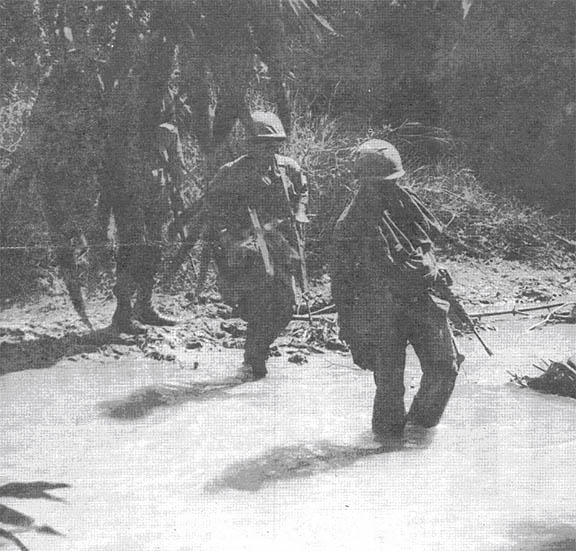 |
| DOWN BY THE RIVER - ”Manchus” of the 4th Bn, 9th Inf, cross a stream on a reconnaissance in force mission 40 kms northeast of Tay Ninh, during the 25th Inf Div’s Operation Yellowstone. (Photo By SP4 Todd Dexter) |
Ingenuity Comes Through With Laundry
TAY NINH - In days gone by, that remarkable phenomena known as “G.I.
Ingenuity” has proved itself time and time again during periods of crisis.
During the recent surge of enemy activity during the Tet holiday period,
laundry service to the Tay Ninh base camp was brought to a standstill, leaving
many soldiers without a clean change of clothes. Out of this crisis
materialized Stogie’s Laundry of the 3rd Sqdn, 17th Air Cav.
Situated near the B Trp mess hall, the laundry consists of a large aircraft
wing tank in which the needed water supply is stored, a pressurized 55-gallon
oil drum, a one-half horsepower Franklin electric pump, an old washing machine
and half of another 55-gallon drum for rinsing the clothes.
The water from the supply barrel is drawn into the pressurized drum by the
electric pump and from there run into the washer.
A shut-off valve between the supply and pressure tanks gives an indication of
the ingenuity used in the laundry’s construction. The valve consists of a small
bedspring, the top nozzle from a canteen and a birdie from a badminton set.
“We knew the principal of the shut-off valve when we constructed it,” stated
1SG James M. Connolly of Fayetteville, N.C., “but it sure surprised us when it
actually worked.”
“The first sergeant’s next project is a flush toilet,” says the squadron’s
sergeant major, Patrick H. Diener of Green Bay, Wisc., “you never can tell what
those inventive minds in B Trp are going to come up with next.”
Excuse Me, I Thought I Knew You
2ND BDE - PFC Lionel Harvey of South Petersburg, Fla., may not be fluent in
Vietnamese, but he speaks enough for a Viet Cong to mistake him for a buddy.
Co A of the 25th Inf Div 2nd Bn, 27th Inf “Wolfhounds”, was sweeping through
an enemy base camp in the Ho Bo Woods when Harvey heard movement in a bunker.
The rifleman dropped to the ground and yelled, “Lai day!” Vietnamese for
“come here.”
Harvey saw more movement, then a smiling Viet Cong popped up above a trench
connected to the bunker.
“I’ve never seen a man change his expression so fast,” said SSG Russell R.
Peters of Coatsburg, Ill., who was standing nearby.
“He actually thought Harvey was another VC calling him,” he added.
The Operation Saratoga infantrymen killed the enemy as he lunged for his
weapon.
Page 2 TROPIC LIGHTNING NEWS March 18, 1968
Decorated
| SILVER STAR | |
|
LTC William L. Albright, HHB, 2nd Bn, 77th Arty LTC Walter E. Adams, HHC, 2nd Bn, 27th Inf LTC Rapheal D. Tice, HHC, 2nd Bn, 12th Inf MAJ Luther C. Vaughn, HHC, 1st Bn, 27th Inf CPT Michael A. Moran, Co C, 1st Bn, 27th Inf |
SP4 Vincent Iacono, A Trp, 3rd Sqdn, 4th Cav SP4 John S. Yoshikane, Co B, 2nd Bn (Mech), 22nd Inf SP4 Robert C. Jones, HHC, 1st Bn (Mech), 5th Inf PFC Paul N. Harvey, Co D, 1st Bn, 27th Inf |
|
DISTINGUISHED FLYING CROSS |
|
|
MAJ Thomas E. Fleming, Trp D (Air), 3rd Sgdn, 4th Cav CPT William A. Wide, Trp D (Air), 3rd Sgdn, 4th Cav 1LT John G. Kulhavi, Co A, 25th Avn Bn 1LT James W. Halley, Co. A, 25th Avn Bn |
WO1 Larry B. Harlamert, Trp D (Air), 3rd Sqdn, 4th Cav WO1 Thomas J. Richardson, Co A, 25th Avn Bn WO1 Patrick J. Bilyk, HHC, 3rd Bde |
|
BRONZE STAR MEDAL (HEROISM) |
|
|
CPT John R. Wells, Co C, 1st Bn (Mech), 5th Inf CPT Kenneth W. Lucas, Co C, 1st Bn (Mech), 5th Inf CPT Cherries P. Watkins, HHC, 1st Bn (Mech), 5th Inf CPT Albert G. Killgrove, Co A, 4th Bn, 9th Inf 1LT Robert E. Poken, Co C, 2nd Bn, 14th Inf 1LT Denton C. Jones, Co A, 1st Bn, 27th Inf 2LT Joseph J. McCusker, Co B, 1st Bn (Mech), 5th Inf 2LT John A. Anderson, Co B, 1st Bn (Mech), 5th Inf 2LT Joe M. Sample, Co B, 1st Bn (Mech), 5th Inf PSG Nelson Rodriquez-Diaz, Co C, 2nd Bn, 27th Inf PSG Kenneth J. Gardner, Co D, 2nd Bn, 27th Inf SFC Chester D. Bradshaw, HHC, 2nd Bn, 12th Inf SSG Anthony Liebhardt, HHC, 2nd Bn, 12th Inf SSG Emanuel Simpkins, Co D, 2nd Bn, 27th Inf |
SSG Anthony Ruffin, Co D, 2nd Bn, 27th Inf SP5 James E. Burke, HHC, 1st Bn (Mech), 5th Inf SGT David Torre Dela, HHC, 1st Bn (Mech), 5th Inf SP4 Michael D. Poland, Co D, 1st Bn, 27th Inf SP4 Harold D. Sumrall, Co D, 2nd Bn, 27th Inf PFC Terrance J. Toomey, Co D, 2nd Bn, 27th Inf PFC Richard M. Peiguss, Co B, 2nd Bn, 27th Inf PFC Joseph C. Knight, Co D, 1st Bn, 27th Inf PFC Ronald D. Tomasich, Btry C, 7th Bn, 11th Arty PFC Leroy Ortiz, Co D, 1st Bn, 27th Inf PFC Harold E. Rooks, Co A, 4th Bn, 9th Inf PFC Dewin Polidura, Co B, 1st Bn, 27th Inf PFC Edward J. Weik, A Trp, 3rd Sqdn, 4th Cav PFC George A. Lyons, Co A, 4th Bn, 9th Inf |
|
AIR MEDAL (HEROISM) |
|
|
LTC Alfred M. Bracy, HHC, 2nd Bn, 14th Inf MAJ James D. Beam, Co A, 25th Avn Bn CPT Frederick Wiese, HHC, 4th Bn, 9th Inf CPT William A. Wilde, Trp D (Air), 3rd Sgdn, 4th Cav 1LT Jack L. Belsman, Co A, 25th Avn Bn 1LT Frederick R. Bagby, Co A, 25th Avn Bn CW2 Ralph M. Griem, Co A, 25th Avn Bn CW2 Lenard P. Ayers, Trp D (Air), 3rd Sqdn, 4th Cav WOl Charles A. Hagan, Trp D (Air), 3rd Sqdn, 4th Cav WO1 Douglas C. Dixon, Co A, 25th Avn Bn WO1 Patrick G. Gillespie, Co A, 25th Avn Bn WO] Jeffery D. Halliday, Trp D (Air), 3rd Sgdn, 4th Cav WO1 Dennis E. Anspach, Trp D (Air), 3rd Sqdn, 4th Cav SP5 Francis Dalcour, Trp D (Air), 3rd Sqdn, 4th Cav SGT James S. Black, Trp D (Air), 3rd Sgdn, 4th Cav SP5 Carl W. Reisch, Co A, 25th Avn Bn SP5 Paul C. Davidson, D Trp (Air), 3rd Sqdn, 4th Cav |
SP5 Merwin E. Lyon, Co A, 25th Avn Bn SP5 George A. Chairo, Trp D (Air), 3rd Sqdn, 4th Cav SP4 Jerry Roberts, Trp D (Air), 3rd Sgdn, 4th Cav SP4 John A. Carpentieri, Co. A, 25th Avn Bn SP4 Jimmie L. Weber, Co A, 25th Avn Bn SP4 John P. Barsch, D Trp (Air). 3rd Sqdn. 4th Cav. SP4 Guy D. Miller, Co A, 25th Avn Bn SP4 Richard D. Hamady, Co A, 25th Avn Bn SP4 Paul F. Hutson, Trp D (Air), 3rd Sqdn, 4th Cav SP4 John Pulliatte, Co A, 25th Avn Bn SP4 Louis R. Beam Jr., Co A, 25th Avn Bn SP4 Michael W. Vossen, Co A, 25th Avn Bn SP4 Guy D. Miller, Co A, 25th Avn Bn SP4 Richard D. Hamady, Co A, 25th Avn Bn SP4 William A. Clark, Co A, 25th Avn Bn SP4 Terrell D. Gruzensky, Trp D (Air), 3rd Sqdn, 4th Cav PFC Larry Trowbridge, Co A, 25th Avn Bn |
Like to Change Jobs?
AG Section
Have you been thinking of a change in jobs during your tour in Vietnam? If
you are an enlisted member the USARV regulation you want is 614-4, “In-Country
Reassignment, Surplus Reporting and In-Country Infusion of Enlisted Personnel.”
That directive sets forth the policies and procedures for in-country
reassignments. For officer members the directive is USARV regulation 614-10,
”Assignment of Officer Personnel.”
Because the majority of you will probably be more interested in USARV Reg
614-4, here is some additional information. For one thing, personnel in grades
E3 through E6 who have a primary MOS in career group 11 (Combat Infantry) who
have been in-country for six months with a non-tactical unit may apply for
in-country reassignment to a tactical unit. For another thing, voluntary
requests for in-country reassignment from personnel who have a primary MOS other
than career group 11 normally will be denied unless urgent military or personal
reasons exist.
However, it is USARV policy to approve individual requests for reassignment
which are submitted together with a request for an extension of the foreign
service tour for at least six months under the conditions authorized in para 8
of USARV Reg 614-4. To be eligible for reassignment in conjunction with such an
extension of foreign service tour the individual must:
(1) Comply with para 5, USARV Reg 614-30, which pertains to extending the
foreign service tour.
(2) Have sufficient service remaining to complete the adjusted foreign
service tour, or agree to reenlist or amend enlistment to acquire sufficient
service prior to reassignment.
(3) Serve a minimum of ten months in original unit of assignment in RVN prior
to date of transfer.
(4) Be MOS qualified and physically fit for duty in the organization
requested.
(5) Have a record free of time lost under Section 972, Title 10, United
States Code, during current tour in RVN, and have a record free of
courts-martial for the past six months.
(6) Be acceptable to the gaining command.
RA Program Soon To Start For WO’s
WASHINGTON (ANF) - U.S. Army Warrant Officers soon will have the opportunity
to take the initiative in applying for appointment to the Regular Army.
A new Regular Army Warrant Officer Program is scheduled to become effective
July 1, 1968.
The selection and subsequent appointments will be on a “best qualified”
basis, as determined by the standing Regular Army selection board.
To be eligible, an individual must have served on active duty as an Army
Warrant Officer for at least three years, with at least one of those years spent
in the Military Occupational Specialty (MOS) in which the Regular Army
appointment is sought.
Other eligibility requirements specify that the applicant must be able to
complete 30 years active Federal service by age 62, and that he be a United
States citizen.
It appears now that appointments will be authorized initially in nearly all
Warrant Officer specialties.
The program is aimed at a strength of 9,000. Details will be announced soon
in AR 601-101 and DA Circular 601-25.
Orders Required Inside Bags When Leaving
Personnel booked for flights on Military Airlift Command (MAC) or commercial
aircraft must place a copy of pertinent travel orders in the inside of each
piece of checked or unchecked luggage.
According to Department of the Army Message 811945, tags should also be
attached to the outside of the luggage, regardless of whether it is checked or
unchecked.
Should the outside tags become obliterated or detached, the orders inside the
baggage will aid in identification and delivery. (ANF)
Report Lost Ration Card Immediately
What must you do if you lose your ration card?
1) report the loss in writing to your current ration card control officer
through your unit commander, immediate supervisor or sponsoring agency;
2) fill out two copies of combination report of loss request for replacement;
and
3) if you want to request replacement action fill out three copies of the
report and two copies of MACV 365-R form.
Your ration card control officer may later issue you a replacement card with
sections on controllable items blocked out except for the ones issued on a
monthly ration basis or authorized by an approved certificate.
A word of caution: the PX patron who loses his card three or more times will
be investigated.
The TROPIC LIGHTNING NEWS is an authorized publication of the 25th
Infantry Division. It is published weekly for all division units in the Republic of
Vietnam by the Information Office, 25th Infantry Division, APO San Francisco
96225. Army News Features, Army Photo Features, Armed Forces Press Service and Armed
Forces News Bureau material are used. Views and opinions expressed are not necessarily
those of the Department of the Army. Printed in Tokyo, Japan, by Pacific Stars and
Stripes.
MG F. K. Mearns . . . . . . . . . Commanding General
MAJ Bernard S. Rhees . . . . Information Officer
1LT James R. Leman . . . . . . Officer-in-Charge
SP5 Terry Richard . . . . . . . . Editor
SP5 Dave Cushman . . . . . . . Editorial Assistant
Page 3 TROPIC LIGHTNING NEWS March 18, 1968
You Are Defending It –
Why Not Exercise It
On the first Tuesday after the first Monday in Nov, 1968, America will elect
a President.
A nation and a people will exercise freedom’s most precious privilege, the
right to vote.
It happens, and has happened, every four years in the United States since
1789. No other nation on earth has a history of free elections that is as old
and as continuous as the voting for President in America.
Through the years, the election of a President has become, symbolically, the
single most important election in the United States. For it is an election in
which all of the people take part.
The preservation and perpetuation of this democratic heritage has depended
every four years, on Americans who cherished and exercised their right of free
choice.
Once again, in 1968, sixty million people will have the opportunity to renew
the faith of our founding fathers on the first Tuesday after the first Monday in
Nov.
Twelve million men and women are in service. But, through the use of
absentee ballots, they can make their choice known, their voices heard. In war,
as in peace, the United States witnesses the stability of its government through
the strength of its elections.
In elections where tens of millions of votes are cast, there is a tendency to
minimize the importance of a single vote or a handful of votes.
The election of 1916 provides a graphic example of how a handful of votes can
swing an entire state and how a single state can decide a Presidential
election. Woodrow Wilson carried Calif by some 3,700 votes and the state’s
electoral votes provided the majority that he needed to be reelected.
Thus, barely two ten-thousandths of one percent of the 17,000,000 votes cast
in 1916 decided the election in favor of Wilson.
In each of these contests, every vote is important, every vote counts.
See Your Voting Officer
Get An Absentee Ballot
Are you 21? Are you a citizen of the United States of America? Are you
going to be stationed in VN through Nov 5, 1968? If you are, then you should
check into the requirements to vote by absentee ballot.
Most troops in VN fall under the Federal Voting Assistance Act of 1955, which
is a federal voting assistance program designed to help persons vote by absentee
ballot when their duty or service requires them to be away from their legal
voting place at election time.
This act applies to all active-duty members of the Armed Forces and their
dependents. It also applies to several other groups, including civilian
employees of the United States serving outside the continental United States
(the voting information booklet will fill each person in on the process
concerning his or her situation).
The act sets up recommended procedures for absentee voting by specified
categories of people as guidance for the states.
But each state makes its own voting laws. It is important, therefore, to
consult the summaries of the laws of each state in question (again this will be
available in the voting information booklet).
You should contact your respective voting officer for information on this
subject.
The Federal Post Card Application for Absentee Ballot, FPCA, is a special
application form printed and distributed by the U.S. government.
The form may be used to apply for an absentee ballot and registration if the
state or territory so authorizes.
Registration procedures also vary from state to state. But one thing to keep
in mind is that you should register as early as the state permits, especially in
cases where registration must be completed before application may be made for
absentee ballot.
See your voting officer and get the low-down on your state’s requirements.
Protect your privilege of voting with action.
|
TABLE OF 1968 ELECTIONS |
||||
|
General Elections in all States, the District of Columbia, and Territories-November
5, 1968 |
||||
|
Page 4-5 TROPIC LIGHTNING NEWS March 18, 1968
OPERATION ‘SARATOGA’
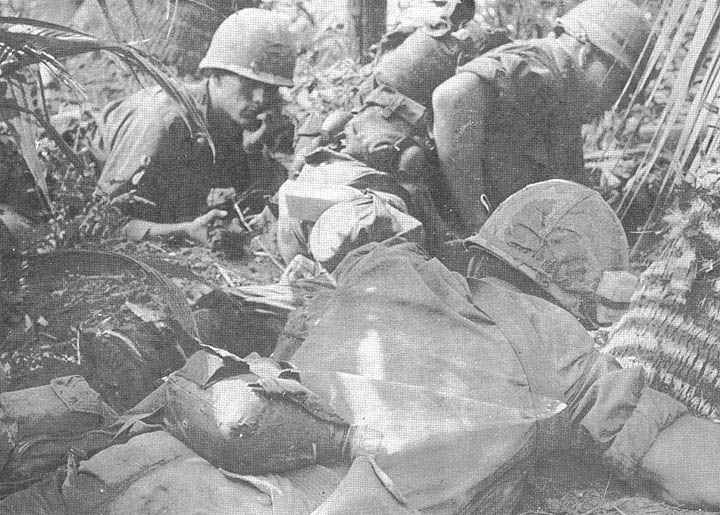 |
| JUST WAITING - Wolfhounds of the 25th Inf Div’s lst Bn, 27th Inf, take cover as sniper fire erupts in a forest area near Saigon. The troops were participating in the 2nd Bde’s Operation Saratoga. (Photo by SP4 Ross Roessler) |
| WET FEET - 1LT Wayne L. Obuszewski, an artillery forward observer for the 1st Bn, 27th Inf “Wolfhounds”, balances his way across a log bridge during a 25th Inf Div reconnaissance in force near Saigon. (Photo By SP4 Ross Roessler) |
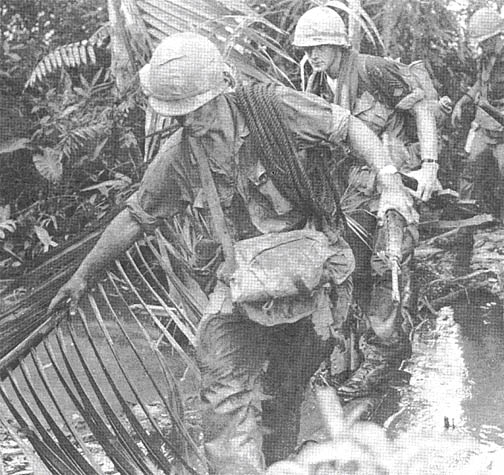 |
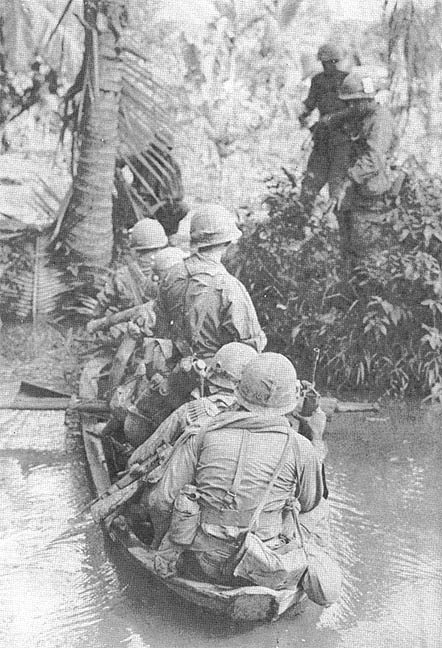 |
INFANTRY GOES AMPHIBIOUS – Troops of the 1st Wolfhounds go amphibious as they cross a canal by sampan five kms north of Saigon. (Photo by SP4 Ross Roessler) |
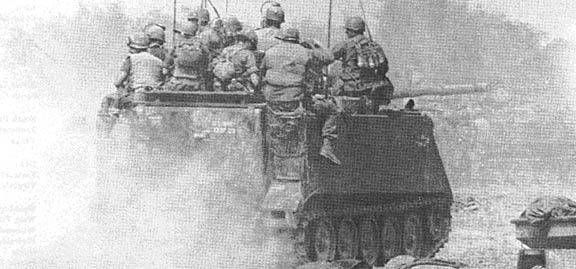 |
| MOVING OUT - An armored personnel carrier of the 25th Div’s 1st Bn.(Mech), 5th Inf, moves out on a reconnaissance in force mission near Hoc Mon. (Photo By SGT Roger Smith) |
Page 6 TROPIC LIGHTNING NEWS March 18, 1968
Golden Dragons ‘For The Birds’
1ST BDE - A pigeon found on a reconnaissance in force operation near the 1st
Bde base camp at Tay Ninh, has become the mascot of the 2nd Plt of Co D, 2nd Bn,
14th Inf.
While sweeping the jungles of Tay Ninh Province, the “Golden Dragons” came
upon an enemy base camp with many permanent type bunkers. The Viet Cong had
fled the area just before the Dragons arrived, leaving the pigeon.
The searching 25th Inf Div troopers were quick to notice the pigeon in an
oval shaped cage hanging in a tree. “The men of the platoon have been saying
all along that they would like to have a mascot,” said SGT Melvin L. Jackson of
New Orleans, “and this looked like as practical a mascot as any.”
After returning to base camp, the platoon searched for a closer
identification. The study proved that their cache was known as an Eurasian
pigeon and the men decided to name their mascot “Eurasia.”
“At one time Eurasia might have been used by the Viet Cong as a messenger
pigeon, but from now on he will be confined to his cage,” remarked platoon
leader LT Garfield Washington of Salem, N.J.
“The platoon intends to keep Eurasia as a mascot in remembrance of the day
Delta found a pigeon,” stated Washington.
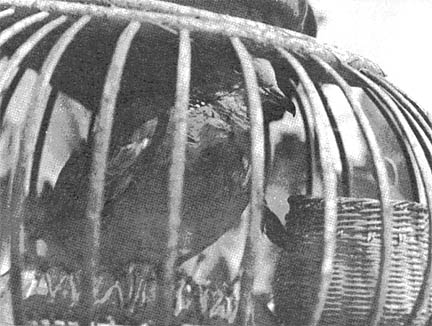 |
DRAGON MASCOT - A Eurasian pigeon detained by members of the 25th Inf Div’s 2nd Bn, 14th Inf, surveys its new surroundings at the Tay Ninh base camp. The bird was found in its cage in a VC base camp. (Photo by SP4 Marty Caldwell) |
Hot News,
No Freeze
“There is no ‘freeze’ on discharges and retirements in any of the services,”
the Department of Defense said the last week in January, replying to rumors
following the call-up of certain reservists. At present, there is no authority
to extend enlistment contracts for enlisted men.
Referring to the status of regular officers, DOD said all services use a
selective involuntary retention program.
There is an individual determination as to whether a regular officer’s
request for voluntary retirement or resignation will be accepted or deferred
because his services are needed. The same applies for voluntary retirement for
Reserve officers.
Reserve officers’ requests for release from active duty are being approved
unless the officer has not completed a term of active duty to which he is
obligated or for which he consented.
The call-up of certain Ready Reserve units of the Air Force and Navy and the
Air National Guard was taken as “a precautionary measure to strengthen our
forces” following the capture of the USS Pueblo by North Koreans on Jan. 23.
Although there was no call-up of Army and Marine Corps Reserve units,
procedures on exemptions were spelled out should the situation change:
• If Army Reserve and/or National Guard units are called to active duty,
exemption policies are covered in AR 601-25.
• If any Marine Corps units are called, the Marine Corps will decide at that
time who, if anyone, will be exempt. At this time, no one would be exempt.
Special Tet Assistance For VC Victims
SAIGON (MACV) - General Westmoreland has announced the launching of the Tet
Aggression Relief Project (TARP), a voluntary program to assist Vietnamese
civilians who fell innocent victim to the brutal Viet Cong and North Vietnamese
offensive over the Lunar New Year holidays.
The project began Feb. 22 and will be carried out through April 2.
Under TARP guidelines, U.S. personnel working for the Department of Defense
in Vietnam -who are in physical contact with victims of the communist-initiated
aggression - are encouraged to provide assistance to those in need of it.
Voluntary contributions may however, be accepted from other individuals and
organizations.
Further TARP guidelines state that the voluntary contributions solicited from
U.S. personnel should be made a part of an organization’s Civic Action Program.
Efforts to provide relief to the Vietnamese people through this project should
be coordinated with the Senior Advisor of the province in which the organization
is operating.
The civilian population suffered heavily in the battles that raged throughout
Vietnam. Many innocent civilians were killed, some of whom had dependents who
are now in immediate need of help. Many Vietnamese were left homeless and in
need of food and clothing.
TARP, by soliciting voluntary contributions from personnel from DOD, seeks to
alleviate the suffering of those who have suffered the most.
Page 7 TROPIC LIGHTNING NEWS March 18, 1968
2LT Platoon Leader Has Nine Lives
2ND BDE - At first 2LT Charles S. Stewart thought it must be a case of three
strikes and you’re out, but as his luck continued, he realized he must own nine
lives.
Stewart, of Walla Walla, Wash., has been rocketed, shot in the head and used
as a backboard for a rifle grenade – and escaped with little more than a
scratch.
Since Sept, he has served as a rifle platoon leader with the 25th Inf Div’s
1st Bn, 27th Inf “Wolfhounds”.
Less than a month after he arrived, a grenade exploded in front of his face
as he crawled towards an enemy bunker. A single piece of shrapnel nicked his
cheek.
The next time, he had given his platoon a lunch break. “While we were
eating,” he recounted, “Charlie moved in behind us. He fired an M-79 round that
glanced off my RTO’s radio and hit me in the back.
“It knocked me down, but it didn’t even leave a bruise. It was a dud.”
His third close call came when enemy gunners opened fire on the battalion’s
forward base camp with mortars and rockets.
“I crawled out of my bunker to get a fix on the enemy. Just as I got out, a
75mm recoilless rifle round landed about 15 feet in front of me, bounced off the
ground, flew over the bunkers and into the tree line and exploded.”
His latest brush with enemy weaponry earned him his second Purple Heart, for
a slight concussion.
“I took a small element to retrieve some casualties. As we were trying to
get in, a bullet went through my steel pot and knocked it off my head.
“I got up kind of in a daze, and an RPG round went off in the tree right
above my head. “I had quite a headache,” he chuckled later, “but not even a
scratch.”
Puppy Luv For Bobcat Troopers
2ND BDE - What began as an effort to save a child from a burning house ended
in a bad case of puppy love for two 25th Inf Div soldiers.
Troops of the 1st Bn (Mech), 5th Inf, were conducting a reconnaissance in
force near Hoc Mon, a suburb of Saigon and the scene of heavy fighting around
the capital.
“We found one bunker with a few supplies in it,” said SSG Jose Rivera of
Bronx, N.Y. “We placed explosives inside and ran for cover.”
The ensuing explosion set fire to a nearby grass hut. PFC Darrel Smith, an
armored personnel carrier driver from Devil’s Lake, N.D. explained, “All of a
sudden, we heard a whimpering noise from inside the house.”
“We found the source just in time,” Rivera said. “One of the walls started
to cave in when we found a small box beside it.”
The pair opened the box - inside huddled three furry brown puppies.
Later that day, the two soldiers gave the puppies away to two little girls
they found crying by the side of a road. The girls went away smiling and the
troops continued their mission.
Job As Policeman
Help Wanted: Men
President Johnson noted in his recent State of the Union Message a national
need for men willing to devote themselves to careers in community service, in
particular, careers as law enforcement officials.
The President especially commented on the desirability of encouraging
returning servicemen to join our nation’s police forces. He noted our
obligation to help local communities to improve their capacity to deal promptly
with local disorders and violators of the law.
Thus the first step in combating crime in our towns and cities is to fill
current vacancies which exist in our legally constituted police forces. To aid
in this recruiting effort, the Department of Defense will permit an early
release of up-to-90 days prior to scheduled separation dates to those servicemen
who choose the police field as a career after leaving active duty. They will be
released in time to meet the starting date of employment or training.
Although the DoD program is aimed at helping all communities throughout the
nation, this fact sheet is primarily concerned with the Washington, D.C. police
recruiting effort. The facts set forth below serve to identify the
opportunities and benefits of a law enforcement career with the District of
Columbia Metropolitan Police Department.
Pay and Allowances
Basic Pay -
Private: First Year $6,700
Second Year $7,040
Third Year $7,380
Fourth Year $7,720
Sixth Year $8,060
• Appointees receive full pay while serving a probationary period of 1 year.
Periodic increases are given for satisfactory service until an annual salary
of $9,420 is reached.
OTHER BENEFITS
• Advancement Opportunities - Based on merit-competitive Civil Service
examination - eligible for Sergeant’s Examination upon completion of 3 years’
satisfactory service.
• Medical Care - Furnished without cost - 13 days sick leave per year - sick
leave can accumulate - injuries or illness incurred in line of duty not
chargeable to sick leave.
• Family Assistance - Low cost Government life insurance available - group
hospitalization available - widow receives 30% of base pay or $1,800 annually,
whichever is greater - each child under 18 receives approximately $50 per month.
• Retirement - Federal and military service count - 20 years’ service at age
50 receive 40% of base pay - 30 years’ service receive 70% of base pay - line of
duty disability receive minimum of 662/3% of base pay.
• Education - Three college credits awarded for 15-week police training -
courses of tuition paid for taking courses in police administration at American
University or University of Maryland.
• Vacation and Holidays - Earn 13-26 days of paid leave per year depending on
length of service - 8 paid holidays each year - military service counts in
computing paid leave.
• Miscellaneous - Uniforms and equipment furnished - eligible to be member of
Police Credit Union, with low interest rate advantage.
Metropolitan Police Force - District of Columbia
To Qualify-Applicant must:
• be a U.S. citizen;
• be 21 through 29 years of age:
• be no less than 5 feet 7 inches tall and no taller than 6 feet 5 inches;
• weigh at least 140 pounds;
• have 20/40 vision, or better, that is correctable to 20/20 with glasses;
• pass a Civil Service written examination;
• pass a physical examination;
• be of good moral character, as determined by a thorough character
investigation;
• reside within 21 miles of the U.S. Capitol Building after appointment;
• have a high school diploma or GED certificate of equivalency - or one
year’s experience as a sworn peace officer - or been a member of a principal
police force of a city with a population of 500,000 or more.
How to Apply
A person who meets the basic qualifications and is stationed within the
Continental United States, Alaska, or Hawaii can apply for an appointment to
take the Civil Service written examination by sending the forms to the address
indicated. These forms can be obtained from your local educational advisor.
Applicants can also use CSC Form 5000-AB (Civil Service Application and Test
Admission Cards) which can be obtained from -
• Most Post Offices
• Nearest Regional Office of the U.S. Civil Service Commission, or
• By writing to Civil Service Commission, Washington, D.C., or the Recruiting
Section, Metropolitan Police Department, Washington, D.C. 20001.
The Department of Defense Police Recruiting Program
To be eligible for early release, you must: (1) have received a firm offer of
employment or notice of training, and (2) be stationed within the Continental
United States, Alaska, or Hawaii. Once you have a letter of appointment and you
meet all other requirements, contact your personnel officer who will assist you
in your application for early separation.
However, you cannot apply more than 180 days before your scheduled date of
separation, although you can make inquiries to the D.C. Police Department or any
other police agency at any time. Remember, you must have a firm offer of
employment by an authorized police agency and you must also have been counseled
concerning fraudulent separation.
Time of Release
If you have 90 days or less of Service time remaining, you will be released
early:
• As soon as administratively feasible if you are offered immediate
employment or training.
• At least 10 days prior to specific reporting date for employment or
training.
All applications will be processed through channels to be established by the
Services.
| SWEET AS CANDY - Pretty Ewa Aulin is our TLN March calendar girl and it’s evident why the month comes in like a lion. | 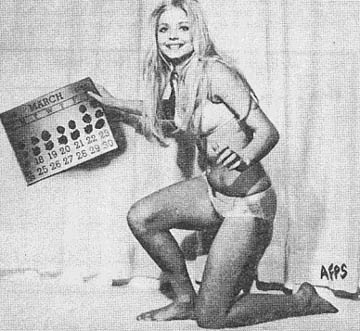 |
Use Back Door For Deliveries
3RD BDE - After being in contact during the day near the village of Tan Hoa,
two kilometers west of Cu Chi, the command group of Bravo Co, 2nd Bn, 12th Inf,
decided to use an old bomb crater for protection that night. But they didn’t
realize at the time how close their protection brought them to Charlie.
Deciding that the hole should be deeper 1SG Everret Clary, Leesville, La.,
had his men start digging but shortly after beginning they exposed a tunnel
which had been covered by the crater.
Set Up
“The men checked out the tunnel the best they could in the darkness,” said
CPT Harry Holter of Chicago, “and after doing so, they filled in the exposed
tunnel and finished setting up the position for the night.”
The next morning Holter had his men uncover the tunnel to conduct a more
thorough search. At this time SP4 Mike Robbins, Pensacola, Fla., entered the
tunnel but came to a sudden stop when an AK-47 was pointed directly between his
eyes.”
“We heard Robbins yell to us to give him a grenade because there were VC in
the tunnel,” continued Holter, “but I knew we had to get him out of there before
we did anything.”
Coming Out
SP4 Albert Calley, Bishop, Ga., acted quickly and grabbed Robbins by the feet
and yanked him from the tunnel. Then he tossed a grenade in the tunnel and
shortly after the VC stuck the butt end of his rifle out and crawled from his
hiding place. The smoke-filled VC was followed by four other Viet Cong who were
armed with two Chicom pistols.
After the VC suspects were under guard, Robbins had the company’s interpreter
question the one detainee as to why he did not shoot the GI. His answer was, “I
was too scared.”
Hearing the suspects reply Robbins replied, “He wasn’t the only one who was
scared.”
Page 8 TROPIC LIGHTNING NEWS March 18, 1968
Mini Force Holds Aerial Night Supply
CU CHI - A mini-task force of 25th Inf Div soldiers and helicopters was
credited with helping save a heavily engaged Popular Forces company in an action
8 kms north of Saigon.
The “task force” staged a daring night resupply for the allied unit, which
was fighting off a heavy Viet Cong ground assault on its compound at Xom Dong
Nhi.
Gunships and “slicks” of Trp D, 3rd Sqdn, 4th Cav, and members of the
headquarters element, 2nd Bde, hovered over the compound, dropping supplies to
the besieged Vietnamese.
According to CPT Peter E. Gleszer of Bangor, Me., an assistant operations
officer, the brigade received a call for help from the compound.
Gathering a carpenter, a mechanic, a colonel’s driver and an information
specialist, Gleszer boarded his team onto the helicopters for the resupply
mission.
Realizing Gleszer might need help, CPT Brian A. Loy of Houston, artillery
liaison officer, volunteered to ride along.
“They took us to the Free World Port at Saigon,” said SP5 George F. Pullen,
of Eugene, Ore., “where we picked up ammunition and rice. Then we flew to the
compound.”
“After the gunships made a couple of passes over the compound, we went in and
pushed stuff out at about 20 feet,” Pullen reported.
Helping him were SP4 Bobby J. Fields of Milwaukee, Wisc., the driver, and SP4
Douglas D. Lawrence of Covington, Ky., the mechanic.
In the other ship, SP4 Kenneth R. Swanson of Ogema, Wisc., the carpenter,
helped Gleszer and Loy hurl supplies from the aircraft.
Co Donates To Homeless KP
3RD BDE - When the Viet Cong activities over Tet resulted in the destruction
of one of Hqs Co, 2nd Bn (Mech), 22nd Inf, Vietnamese kitchen helpers’ home, the
men of the company chipped in to demonstrate their generosity.
When the workers returned to work after the Tet holiday, SSG Herschell L.
Antee, of Columbus, Ga., the company mess sergeant, noticed that one of the
women seemed distraught. He discovered that a Viet Cong terrorist squad had
visited her house, and her house caught fire, destroying all her family’s
possessions.
Immediately Antee started a collection. Over $350 was donated by the men,
well demonstrating the American soldier’s concern for the Vietnamese people.
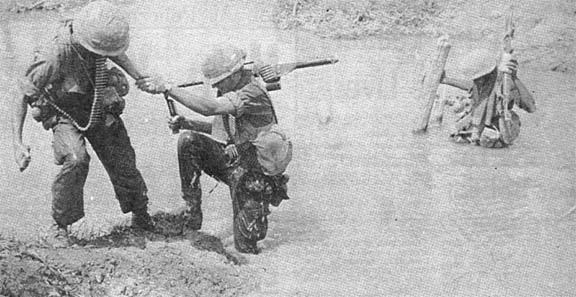 |
| DIRTY BATH - A “Wolfhound” of the 2nd Bn, 27th Inf, helps a buddy cross a canal 15 kms north of Saigon during Operation Saratoga. (Photo By SP4 Joe Carey) |
Mortar Gives PFC Close Shave
3RD BDE - The lives of many men have been saved by wearing a steel pot, but
how many men can boast that their lives were saved by not wearing the “pot”?
PFC Robert VanNorton from Johnson City, N.Y., can.
How many men can boast of being hit by a Viet Cong mortar and lived? Robert
VanNorton can.
It all happened this way:
VanNorton just finished his radio watch while on operations with the 2nd Bn,
12th Inf. Stretching out on the ground at approximately 3 am he was patiently
awaiting the arrival of the “Sandman” when a Viet Cong Force began dropping
heavy mortar and rocket fire into the area 3000 meters north of Cu Chi. He
leaped to his feet and raced toward a bunker.
“Wham! The next thing I knew I was in the air and then flat on my back. I
crawled the rest of the way to the bunker,” he said. A mortar round had flown
past him, the tailfins slicing his head open and detonating less than 20 meters
to his rear.
“I reached the bunker and in just a few minutes a medic wrapped my wound,” he
continued. “I was thanking the stars I wasn’t killed.”
“When they dusted me off I had no real idea how bad I was hurt. I didn’t
think it was too bad.” He had a little trouble getting the doctors to
understand how he could be hit with a mortar and still have a head.
He looks at it this way, “The pot would have been big enough to detonate the
mortar, as it was the most I have is a few stitches and a splitting headache.”
VanNorton assigned to the 2nd Bn, 77th Arty, and attached as an RTO to HHC,
2nd Bn, 12th Inf feels mighty lucky.
 |
UP, UP AND AWAY - SP4 Herbert J. Bergman Jr., a medic with the 25th Inf Div’s 2nd Bn, 27th Inf, pole vaults a canal during Operation Saratoga. (Photo By SP4 Joe Carey) |
Thanks to:
Joe Shipes, Co. B, 25th Aviation Bn.,
for sharing this issue,
Kirk Ramsey, 2nd Bn., 14th Inf. for creating this page.
This page last modified
12-24-2007
©2007 25th Infantry Division Association. All rights reserved.